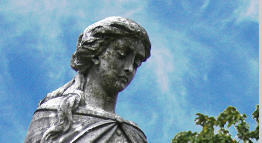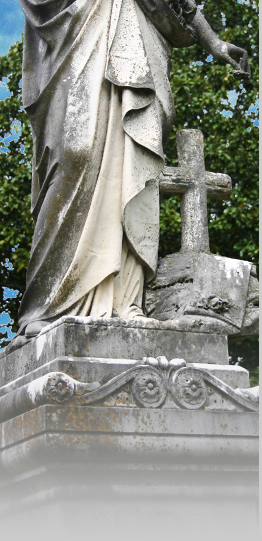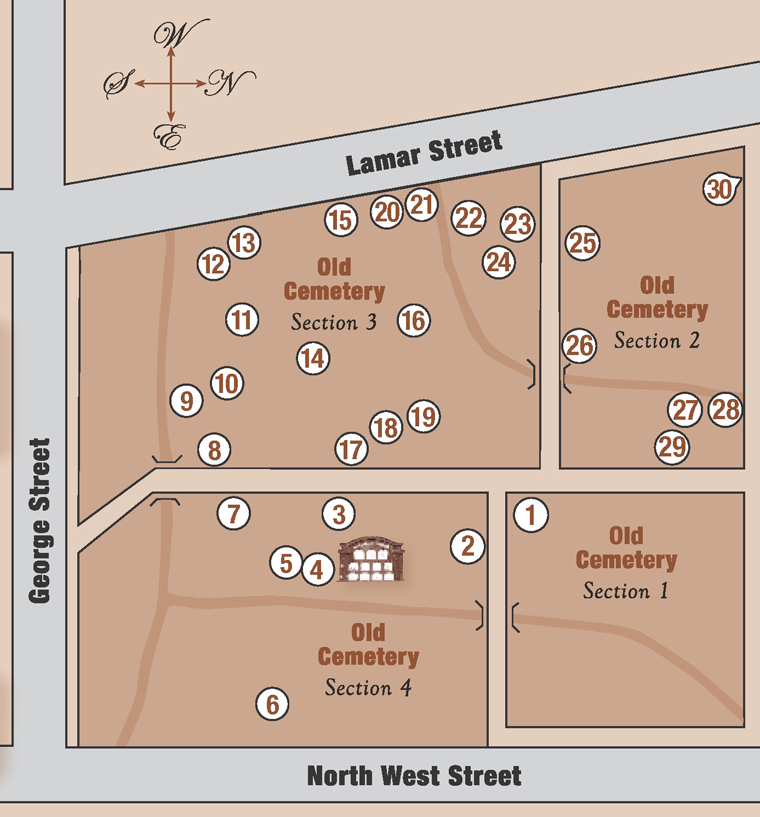




"I'm one of those people who can't not read every tombstone—they scream at me for their names to be heard." –Natasha Tretheway
Many visitors to the cemetery may be surprised at the number of black Mississippians interred at Greenwood, but given the complex history of the region and of race relations in Mississippi, that surprise may soon give way to a deeper consideration of the commonalities of our human condition. This walking tour deepens our understanding of Jackson history by revealing what such tours usually gloss over: the rich tapestry of human achievement beyond the usual luminaries. Interred in the cemetery are laborers, business men and women, housewives, farmers, bakers, midwives, teachers, and former slaves.
Taken together, these representative lives help us to imagine a more vibrant community history; considered alongside their white counterparts, we may begin to wonder at the false divisions crafted by political and social policy which kept apart in life those who lie side by side in death. For example, census data reveals shifting legal classifications as the nation sought to define what it meant to be "white" and "not-white"; Benjamin F. Hardy, Alabama native and buried here at Greenwood, went from a classification of "white" to "black" in a matter of three federal census takings.
As is always the case, the scant information on display in a cemetery surfaces more questions upon contemplation than answers.
We invite and encourage you to follow whatever paths of inquiry your tour today may suggest to you.
The complete list of nearly ninety African American monuments is available by email, as is a work-in-progress list of unmarked African American graves. Requests should be sent to greenwoodcemeteryjackson@gmail.com.

| 1. John Moore and Martha Webb Moore | John Moore and Martha Webb Moore were both born in Mississippi. John Moore was a carpenter, and Martha Moore was a cook. John's monument is marked by the Grand United Order of Odd Fellows, and Martha's monument is marked by the Household of Ruth, the female counterpart to the GUOOF. Social organizations like the Grand United Order of Odd Fellows were formed to counter the prohibition of black members in white organizations like the Independent Order of Odd Fellows. |
| 2. Isaac Washington | Isaac Washington's marker also bears the insignia of the GUOOF Lodge 8722. He worked as a fish peddler and died of an internal injury at the age of seventy-eight. He is buried in a lot with Phillis Johnson and her daughter Julia Johnson Jones. Phillis Johnson was born in 1856 in Mississippi On the 1900 census, Phillis was listed as a widow and was the head of the household, working as a laundrywoman and living in a rented house on Monument Street. While Phillis could neither read nor write, all four of her children, Rosa, Fannie, Joseph, and Julia, were able to do so. |
| 3. Henry V. Thomas and Fannie C. Thomas | Henry V. Thomas and Fannie C. Thomas owned a florist shop, where they both worked. |
| 4. William Henry Lanier | William Henry Lanier was the first Superintendent of Jackson Colored Schools. He was born a slave in Huntsville, AL. He studied at Tougaloo, Oberlin, and Fisk Colleges and received a B.A. from Roger Williams University. He served as President of Alcorn College for six years and was the Principal of Robertson School from 1912-1929. Lanier High School is so named in his memory. |
| 5. Junius A Tharp | Junius A Tharp was a bricklayer. His wife, Olivia, was a nurse. They had three children: Doris, Catherine, and Sidney. Sidney R. Tharp went on to become a lawyer with offices on N. Farish Street. |
| 6. Evangeline Byrd | Evangeline Byrd, was a well-known and highly respected midwife. A widow according to the 1920 census, she lived with her son William and daughter Ola at her home on Church Street. Augustus M. Redmond, pharmacist at Redmond Drug Store on Farish Street is entombed in the brick vault south of Evangeline. |
| 7. Sarah "Sallie" Campbell Dawson | Sarah "Sallie" Campbell Dawson—Sarah Dawson was born in Missouri in 1846 and was a teacher at Smith Robertson School in Jackson. She was married to William Dawson, a plasterer. She is buried in this plot with her granddaughters, Ruby Alma Dawson, Georgia B. Dawson, and Lillian M. Dawson. Ruby and Georgia were also teachers at Smith Robertson School. Dawson Elementary School in Jackson is named after her Granddaughter Georgia B. Dawson. |
| 8. Maria Risher | According to the 1900 census, Maria Risher was a widowed seamstress. The family's company, Risher Bakery Co., provided employment opportunities for various members of the family. Next to her is Maria C. Greene who was of mixed race and married to a railroad worker by the name of Robert Greene. Around 1920, Robert was enumerated in Washington D.C., living with a son or daughter, while Maria lived with her other children and her mother in Jackson. Directly behind them is Jesse Hobbs, who died in 1865, and is believed to have been a freed slave. If so, his is the oldest African American monument in the cemetery. |
| 9. Helen M. Glover | Helen M. Glover—On the 1880 census, the Glover family was listed as a family of mixed race. Her father, George Glover, was a carriage maker and her mother Lucy worked as a midwife. |
| 10. Mariah Span Cade | Mariah Span Cade—Mariah Cade was born in Mississippi and married Isham C. Cade, a man of mixed race born in Tennessee in 1835. Isham was a baker by trade. According to the 1870 census, both Mariah and Isham worked at the Insane Asylum. |
| 11. Reverend Marion Dunbar | Reverend Marion Dunbar, a Georgia native, was a deacon for the black slaves who were allowed to hold services in the basement of the First Baptist Church and the first pastor at Mt. Helm Baptist Church, the first church for African Americans in Jackson. Dunbar is also listed as a blacksmith in the 1870 census. His wife, Lydia, was a native of South Carolina. |
| 12. Earle Willard and Jimmie Neil Banks | 12. Earle Willard and Jimmie Neil Banks—The Bankses were the proprietors of Peoples Funeral Home (est. 1925) located on Farish Street, where their son, Earle W. Banks Jr, later worked as an undertaker. Mrs. Banks was a lifelong resident of Jackson. She attended Holy Ghost Catholic School, the first black Catholic school in Jackson, and graduated valedictorian of her class. She went on to attend Tougaloo College and married in 1926. After her husband's death in 1985, Mrs. Banks became part owner of the funeral home and was an avid seamstress, gardener, and writer until she died of heart failure in 1998 at the age of 93. |
| 13. Archie B. Hopkins | Archie B. Hopkins and her daughters Lula Mae and Albertine (Mason) lived with Archie's mother Irene Reid (1872-1947) and Irene's husband Moses Reid. Archie taught at Mary C. Jones School. Both daughters became teachers. Lula Mae married Lucius Patton, who was also a school teacher. She taught at Smith Robertson School and E. A. Ware School. Albertine Mason taught at Lanier and Murrah High Schools. |
| 14. Benjamin F. Hardy | Benjamin F. Hardy—Benjamin Hardy was a native of Alabama. In 1860, he was listed among free white inhabitants with no special designation. On the 1870 census he was listed as white with a black wife, Ellen, and several black children. In 1870 Benjamin became a printer. On the 1880 census he was listed as black, working on a farm. Benjamin died at the age of 56 in 1886. |
| 15. Susan Ross | Born in Virginia, Susan Ross was married to Alex, a teamster/drayman. They had twelve children, nine living by the time of the 1900 census. Three of those children would eventually teach in the public schools and remained in the family home. |
| 16. Charles Morgan | Illustrative of the difficulty in relying on census and directory data, the 1900 census lists Charles Morgan (1845-1902) as a janitor living with his wife Carrie Morgan and their family on Congress Street. In the 1901 City Directory, he is listed as a porter at the post office and living on West Street. |
| 17. Lizzie Rogers | Lizzie Rogers was married to Robert Rogers, a drayman. She died at age thirty-eight of tuberculosis. |
| 18. Mary Jane Miner/Minor | Mary Jane Miner/Minor, widowed by 1900, was an employee of the state Insane Hospital. |
| 19. Lydia Franklin | Lydia Franklin was a native of South Carolina. She was of mixed race and worked as a seamstress. She lived with her husband Arnold, a house servant, in Canton, MS. |
| 20. Mary Wallington | Mary Wallington worked as a washwoman and was married to Henry, a truck farmer. While they lived in Beat 5, not the city of Jackson, she is interred here at Greenwood. |
| 21. Harry S. Marino and Bettie C. Marino | Harry was a porter and cotton sampler for W. J. Davis & Co. Bettie was a teacher at Smith Robertson School. |
| 22. Jennie V. Grayson | Jennie V. Grayson was a single woman of mixed race born in Mississippi. Jennie lived with her brother William and worked as a dressmaker and seamstress. |
| 23. Albert Lee Johnson and his brother, Pinckney J. Johnson, | Albert Lee Johnson and his brother, Pinckney J. Johnson, were Mississippi natives. Albert Johnson's monument bears the insignia of GUOOF Lodge 1927. He is buried next to his brother Pinckney. |
| 24. Virgil Ruffin Sr. | Virgil Ruffin Sr. was a day laborer at Taylor's Brickyard. He and his wife, Sallie, had twelve children. Ten of them were living by the 1900 census. |
| 25. Catherine "Kate" Williams | Catherine "Kate" Williams was born a slave. After emancipation, she continued to work for the Winter family and is buried in their family plot. |
| 26. The Redmond Family | The Redmond Family is buried in a shared vault. Interred here are Dr. Sidney D. Redmond, physician, pharmacist, businessman, and lawyer; his brother, Andrew J. Redmond; his first wife, Ida Revels Redmond; his second wife, Johnnie King Redmond; and his daughter with his second wife, Linnie Naomi Redmond. |
| 27. Professor Samuel Manuel Brinkley | Professor Samuel Manuel Brinkley was an educator who served as teaching principal of Hill School, the first organized junior high school program for African American students in Jackson Public Schools. Brinkley Middle School is named in his honor. His wife is believed to be buried next to him. |
| 28. Laura Ferguson | Laura Ferguson was born in Madison County in 1845. She was married to George Ferguson, a drayman. Daisy, her daughter from a former marriage lived with them and was a music teacher. |
| 29. Susan Jones ("Our Mammy Sue") | Susan Jones ("Our Mammy Sue") was a freed slave who remained with the family for whom she worked until her death. She is interred in the family plot. |
| 30. Secretary of State James D. Lynch | Secretary of State James D. Lynch was born to free black parents in 1839. He graduated from Kimball Academy in New Hampshire at the age of 18. He was unable to continue his education due to the failure of his father's business, so he became a teacher and minister in the AME Church. In 1867, he connected with the Methodist Episcopal Church and relocated to Mississippi. 1n 1869 he was elected to the office of Secretary of State by a large margin; his term was cut short by his death in December of that year due to a chronic lung illness. |